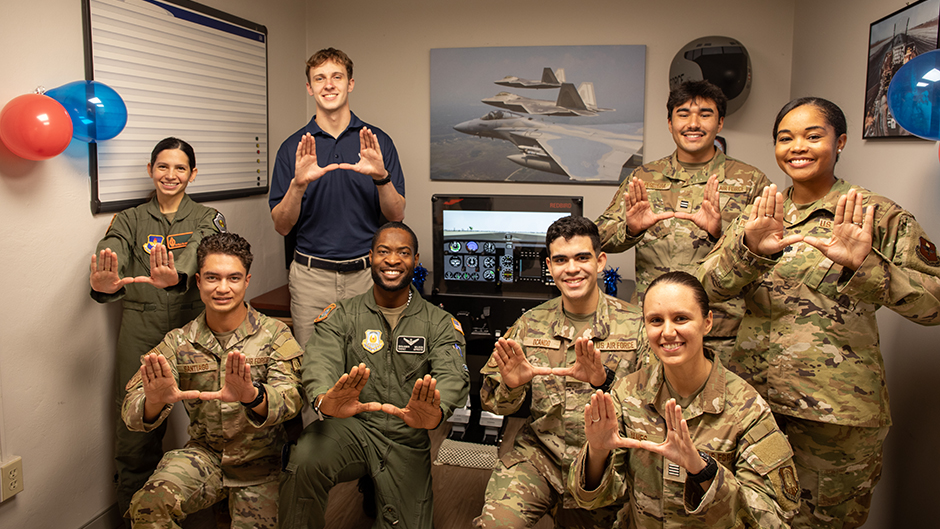Students wishing to learn to fly aircraft are in for a treat. The University of Miami College of Arts and Sciences’ Aerospace Studies Program recently inaugurated its newest flight simulator—the state of the art Redbird TD2, an industry standard training tool for aspiring aviators looking to gain flying experience from the ground.
At a December 7 ribbon-cutting ceremony in the Aerospace Studies/Air Force ROTC Building, professors and cadets gathered to celebrate the sleek, new training device’s highly anticipated arrival.
The simulator is located in the D’Angelo III Simulator Training Facility, a room in the Aerospace Studies building. It is named in honor of Major Samuel D’Angelo III, USAF, a class of 1981 University ROTC graduate who died in 1999 during flight training.
The occasion granted an opportunity for current cadets to express what Maj. D’Angelo’s legacy means to them. “It is important for us to have a sense of heritage in our program,” said Cadet Col. Yanet Yanes. “Naming the room after him is an important way for us to honor him and to remember our history.”
While the Redbird TD2 might look like a highly sophisticated video game to the uninitiated, it is anything but. “The students use the simulator to practice operating in various flight conditions using realistic switchology to improve their flying. It is a valuable form of study,” said Lt. Col. Regina Purnell-Adams, detachment commander and professor of aerospace studies.

All cadets will be encouraged to use the simulator to expose them to aviation. Maj. Pamela Blanco-Coca, assistant professor of aerospace studies, explained that “while putting in time with the simulator will not count for University credit, it will help cadets to improve their TBAS [Test of Basic Aviation Skills] and AFOQT [Air Force Officer Qualifying Test] scores, to make them more competitive for pilot selection.”
With its sensitive controls and full instrument panel, students can simulate flying in day or night conditions. “The simulator gives students the option of flying into any registered airport in the United States,” explained Cadet Lt. Ignacio Ocando, one of the ROTC students present at the ceremony.
Echoing the sentiments of other cadets, Ocando mentioned that he plans to spend ample time honing his skills on the machine. “You don’t want to be practicing when you’re in the cockpit flying. You want to be sure you know how to fly before getting in a cockpit,” he said.
Civilian students looking to learn or improve their flying skills are also welcome to explore the University’s aviation resources.
“UM students not enrolled in ROTC can still take Aerospace Studies courses; UM offers a minor in it,” explained Purnell-Adams. “Students can learn about the Air Force and experience our new flight simulator as well.”
Earlier in the year, Aerospace Studies leadership met with Leonidas Bachas, dean of the College of Arts and Sciences, to discuss ways to support the Air Force ROTC program in reaching their departmental goals. “Dean Bachas has been very supportive of the ROTC program,” said Purnell-Adams.
Both parties agreed that purchasing the simulator will be key to the continued production of outstanding “Hurricane Aces,” the name bestowed on Detachment 155 cadets—both faculty and alumni.
Approximately ten cadets graduate from the University’s Air Force ROTC program each year.
“Of the 65,000 officers in the Air Force & Space Force, approximately 12,000 of those officers are categorized as pilots,” Purnell-Adams said in her remarks during the ribbon-cutting ceremony. “We want our detachment to contribute to the total number of Air Force pilots each year.”

